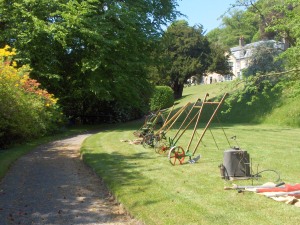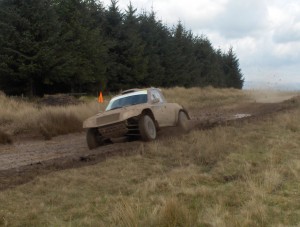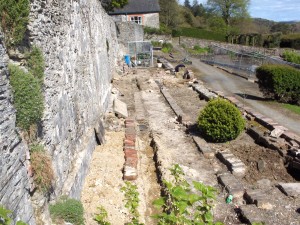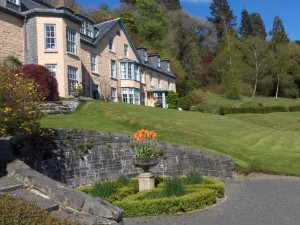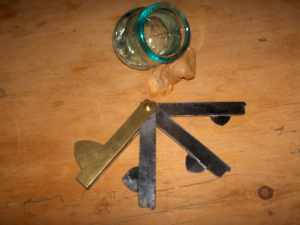It’s almost four years, and it’s also one year, since leg injuries laid me low, crippled me in fact. The first came after a particularly hot day, I had been doing a simple task, gathering stones and loading them into a trailer to take to my work site. That site happened to be just along the road from me at the the estate mansion, where I was rebuilding a large section of the walled garden. The stone was slate waste from the Laird’s quarry, a short distance and not a job I anticipated would take much of the day. One of the consequences of this assumption was that my supply of water was not large – half a litre – as I erroneously expected to be home by lunch-time. Alas gathering and transporting the mile or so took much longer than I expected and I quickly ran out of water, in fact during the last trip, I was gulping from the stream (not to be recommended when there are so many pheasants about !). It turned out to be mucho hot and I distinctly remember being parched. I finally got back and parked the trailer. I reached into it to recover a rope I had been using to secure the load, it had snagged in the trailer but instead of merely walking around the other side to free it, I stretched to reach it and gave a short little hop. ‘Bang!’, I actually thought a stone had dropped onto my heel and looked around to see where it had gone. I stepped back and immediately fell over. I don’t recall there being any pain as such but I had totally lost the ability to move my left foot or stand on it. I managed to crawl back to the house and attempted to remove my wellington boot, to no avail. I began to suspect something serious had happened, I began to suspect my achilles tendon had snapped, I began to be a little apprehensive. I eventually had to cut my left welly away and fished around in my heel/achilles area to see if I could feel anything. It was at that point, with my finger disappearing deep into the back of my foot, that my fears were confirmed, snapped tendon. When I eventually got to hospital – which for various reasons, not least my own stupidity, was some 2 weeks later – the first thing the consultant said to me was “I bet it was the end of the day “. Indeed it was and the reason she knew that was because most such injuries are down to dehydration, the tendon apparently dries up very quickly and is the first to suffer any reduction in the body’s fluid level. She told me that the biggest patient group presenting with such an injury are those who go home from the office or work, get on the bike or running shoes and… kerplunk, rupturing of the achilles tendon. How I well remembered my thirst ! Just over 6 months later, most of which was spent in a foot-to-groin plaster in ‘full equinus’ (foot pointed fully downwards), I began to hobble around in a strange moon-mission type boot with bladders that were pumped up to support the much weakened leg. A year later I was still packing ice around the ankle each evening as I got back to the hotel in Washington D.C. after a hot day on the National Mall, where I made sure I drank gallons of water and nagged those working with me to do the same.
How was it then, (you may well ask!) I ended up last May again writhing on the ground with a severe leg injury ! This time it was the right leg, this time it was not the tendon, thank the Lord, but a ruptured calf muscle, merely an alternative way of the body telling you it had not had enough water ! This time I was ‘simply’ pushing a lawn mower up a steep slope when…… I kind of knew it wasn’t the tendon as the pain was so excruciating as to make me scream, that had not happened the last time. In one sense it was worse for there was nothing that could be done surgically or with plaster, it had to just heal itself . Again I was laid up, again it was down to my own stupidity, again I had not hydrated sufficiently ! The other thing which happened was that I realised how very weak my original left leg injury still was and that the poor old right leg had been carrying all the weight, literally, and doing more than its fair share of work. So now I have one bad leg and one worse one, ha !
A year or four on and things have come full circle, I am about to embark on much walking !

What ever is glorious about mud ?! Trying to walk or work in the claggy, sticky, all consuming mire is very draining on the energy levels and the spirit ! This has been my daily battle for two weeks now…. nice colour though, wouldn’t you say ? (very SC yes ?)
What I realised last year was that I had seriously neglected the rehabilitation, which is to say correct exercise regime, of the original inury. Hopefully I have learned that lesson and have worked hard at getting some of the old strength and fitness back into my leg muscles. I walk as often as I can, and generally, other than some tiredness in the both calf muscles, I manage quite well. Of course the distances are much less than I used to do, a ten mile walk was a common little jaunt for me prior to 2008, now I find I am pushing on and often struggling after the 5-6 mile mark. Depending on the terrain, steep I can do, uneven under feet requires more care – dropping the heel suddenly into a hole or gulley is not a good idea – but I am getting more and more confident and regularly now clock up a six miler on a Sunday afternoon.
This last week has been a severe test of my leg stamina, and my ability to overcome duress ! I unwittingly made a serious mistake on my latest job. Instead of stripping the wall out stone by stone as is best practise, I got a machine to demolish it for me. Now that is something I have often done in the past, for although it means a slightly slower rebuild, due to having to dig around and spread the stone about, the few hours that a machine takes to strip out an old wall saves me two or three days depending on length. It is not worth it for a small section but I had 20 metres of wall to demolish and some of it is made up of quite large stones, so as a machine and driver was available, go to it !

Not sure about this colour, it spoils the lovely scenery of the upper Rhiangoll somewhat, but it made short shrift of that old section of wall.
There was some urgency to get the whole section demolished as quickly as possible. I had noticed that already the summer visitors were beginning to appear. I saw a pair of Wheatears already on site and within a few days Redstarts had arrived and Pied Wagtails were flitting about agitated. Walls are the perfect nesting places for these birds and our summer visitors return each year to the same site. I had managed to survey the wall last summer and had noticed only the Pied Wagtails had nested in this particular section, nevertheless I didn’t want to leave the demolition any longer, there is nothing worse than ruining a nest full of eggs or, worse still, young chicks !!
The problem came in the form of several inches of heavy rain, it absolutely saturated the ground so that when the machine scraped the foundations of the wall out, water immediately poured from the surrounding subsoil into the trench. Within a short time I had trod it into a quagmire from which I have struggled everyday to escape. Each step causes the foot to disappear into the clinging morass and the slightest pause, to place a stone on the wall, means excessive strain to unstick the large boot that encases my weakening lower legs. Any time I might have saved in not demolishing the wall by hand has long since been used up. I am woefully behind and each day leaves me tired and demoralised. To add to the problem the section of wall is four large fields away from the farmyard, where I leave my vehicle. Now normally the walk up to any wall on Grafog is part of the daily pleasure, the return stroll in the evening is always a delight. Just now, not least because the first field is ploughed, the trek through ankle deep mud leaves me having used up half the day’s supply of energy and enthusiasm before e’er the wall is reached !

Oh my, what a mess, mud and stone and me, to separate the three of us is an absolute battle, each stone has to be extricated, scraped of mud, moved by glued feet and webbed hands to an even muddier wall.
The wall itself has stood here for well over 400 years but it had become rather dilapidated and sections of it have been variously robbed-out (stone walls were not highly regarded once they had become un-stockproof and the stone was a valuable resource for use in buildings or for sale) or just lie where they have fallen, moss covered and untidy. One of the problems of assessing the habitat value of a dry stone wall lies in the species being taken into consideration. Much of the conservation policy in this country has been driven by the bird lobby and hence attempts to increase nest sites and food sources have had precedent in agri-environmental programmes. I have often had battles with the officers who monitor and create these plans, often around whether a wall is more important in its collapsed – just a pile of stones – state than ever it would be rebuilt. I rarely have won such an argument and have seen many highly important ‘over-wintering’ sites – that is a habitat area where creatures such as invertebrates and amphibians spend the winter in safety, out of the way of hungry predators or Jack Frost – destroyed after having been there for a hundred years or more. I therefore try as best I can to make the wall I rebuild a good habitat area for all such animals even to the point of creating bird nesting holes, properly constructed with a safe and dry roof, as would be used in an old dilapidated wall.

The old wall was at one time the mountain boundary and this little passage, called a ‘lunky’, allows the sheep to pass through the wall and out onto the hill.
This particular piece of wall is the oldest of the walls on the farm and at one time it formed the drove from the hill to the farms nearby. Just a few hundred yards upstream is a sheep-wash where the hill flocks were brought for dunking in the clear mountain water prior to shearing.
Given the history of the land hereabouts this wall probably dates from the 1600s and is built from stones gathered from the hill and the stream. It is different from the other walls which are primarily built from locally quarried Old Red Sandstone. In one sense it is a shame to demolish it as it has characteristics of those builders who toiled here hundreds of years ago. It is actually possible to track the builders as each section they built in a day is clearly marked by a rather inept ‘straight’ or ‘rip’ joint. This is something that is one of the hallmarks of the late medieval enclosure walls. Wallers were paid on a daily basis and for how much they had erected, it was thus important for them to get a ‘rood’ a day done (the ‘rood’ is the old measurement which strangely varies from place to place but is around 18-21 feet) and of course it had to be completed.
I have really struggled with the rebuilding because of the terrible conditions but progress is being made. It needs to be done soon as I am heading to the Orkneys for some archaeological study, oh yes, and some respite from bad weather ! However, that is not the only change coming my way soon, and the other involves a greater use of these weary legs. I’m going walking….
Some time ago I mentioned beginning a new adventure with some customer friends of mine over in the Llandrindod Wells area. We are going to launch some Guided Walking Breaks with a difference. The area around their farm is a real historical gem, full of antiquity and interesting landscape features. Utilising my interest (some say ‘obsession’ !) in Historical Landscape study and their very fine B & B or self catering accommodation (together with some nearby B & B businesses) we are offering short walking breaks which will examine the prehistoric and medieval features which litter the hillsides within a short radius of their holding.
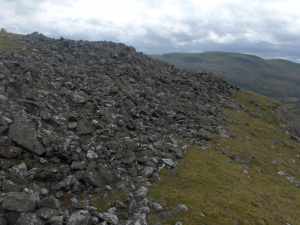
This pile of stone is in fact the defensive ramparts of an Iron Age hillfort. Known somewhat ingloriously as Castle Bank, it sits on a natural rocky outcrop hidden in the Radnorshire hills between Howey and Hundred House.
Within five miles of the farm there are numerous features, the Iron Age is dominant in these forgotten hills and there are a number of ditch and bank defended enclosures. The main camp, Castle Bank, is a univallate (a posh way of saying single ditch and bank !) enclosure which is a huge elongated hilltop fortification surrounded along its less steep side, by stone ramparts. Whilst these are now just piles of stones it is likely that at one time they would have been a built dry stone structure.

The ditch and bank is quite clear along a good length of the hillfort, especially on the northern slopes where the gradient is not so steep as to present an impossible line of attack.
The enclosed area is around 16 acres and the steep slope to the south, covered in loose stone scree, is formidable. Within the camp, which is mainly a bumpy, rocky hilltop, there are several flattened terraces where huts would have stood.
The surrounding field systems and low banks now consumed within the heather and scrub of the common land around the fort, mark the areas where the tribesmen would have farmed. The views are extensive from the fort, 30 miles or so to the western hemisphere and 20 miles or so to the eastern. On the surrounding skylines are smaller hillforts all having a clear line-of-sight to this major camp. These satellite camps are assumed to have belonged to the extended clan and the clustering of such hillforts is currently being plotted throughout south Wales by my old University Professor, Dr. Ray Howells.
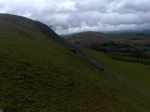
The steep rocky scree presents an impenetratable defense along the southern approaches to the hillfort.
In addition to the Iron Age features there are relic field systems thought to date from the Bronze Age and a number of stone cairns which dominate the skyline. The small area, framed by the Builth Wells to Llandrindod Wells and the Builth to Hundred House and on to Llanfihangel Nant Melyn roadways, is indeed a wonderful area to wander in. The walking is not too onerous and the pathways are grassy turf with wide open panoramas in every direction.
Of course, dry stone walls also dominate the area – well they would wouldn’t they ! – and these too provide a very interesting clue to the stratigraphy of the historic landscape. The encroachment of the fields up onto the open hill and the way the farmsteads nestle along the spring-line show how farming was effected by and absorbed the climatic and political changes which ranged forth over this area for hundred of years. Place names too provide a fascinating insight into the old socio-political structures with many Welsh names, such as Pen Tre (meaning the top of the township, or estate, the Tref), and of course the very clear ‘Hundred House’, a reference to the old Cantref, or system of dividing an area into a hundred homesteads.
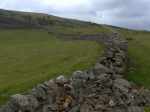
‘The wall walks the hill, millipede like’. The old walls of the Disserth Betws area hold the secret to its evolution.
The whole area has some delightful little relics of ages past, including its place in the folklore of Cattle Droving, with a major old route passing through the area. I am excited to get going, to get walking, and show off this hidden corner of Wales.
As well as the more historic walking days we are also beginning some short courses relating to the ‘Why’s and Wherefore’s’ of dry stone walls, which again consists of short guided walks looking at walls in their environment and learning about why they are where they are, who put them there and when. I have been developing dating models for dry stone walls over a number of years now and have some clear indicators which allow an estimate of the period in which a wall was constructed to be deduced from the way the stones are laid and the wall built. This area is full of excellent uncorrupted walls, that is they haven’t been rebuilt by someone like me who comes along and ruins the historical integrity !

Old farmsteads lie in ruins beneath the great hillfort, giving yet more clues to the history of this fascinating corner of Radnorshire.
The two day course also offers the chance to have a go at building a dry stone wall having learned the skills and seen the old walls in the surrounding countryside.
This development, this ‘diversification’ from my usual activities, gives me the chance to share some of my knowledge and interest with others, and, hopefully, still pay some bills ! Who knows, I might even get to meet one of YOU, faithful long suffering readers of the ramblings of Welshwaller !
If you want to find out more about the courses ( and I genuinely apologise for this bit of advertising !) go to:
www.tygwynfarm.co.uk

This is the area where we will go exploring; the old Drovers road from Howey to Hundred House, winds over the open hill, another element in the history of this quiet corner of my favourite Welsh county.




